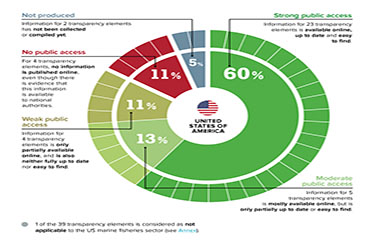The Fishery Transparency Initiative (FiTI), a global partnership aiming to increase transparency and participation in marine sustainable management among fisheries, released an assessment on 28 February labeling the U.S. as a global leader in fisheries transparency.
FiTI published the report, “Taking Stock: Online Transparency of Fisheries Management Information for the United States of America,” as part of its Taking Stock assessment series, which provides countries with an investigative analysis highlighting where their fishery transparency efforts currently stand.
According to the U.S. report, 60 percent of transparency elements within the country have “strong public access,” 13 percent have a label of “moderate public access,” 11 percent have “weak public access,” 11 percent have “no public access,” and 5 percent are classified as “no [analysis] produced or collected yet.”
“The main finding is really that the U.S. is a global leader when it comes to making that information publicly available,” FiTI International Secretariat Executive Director Sven Biermann said. “We also found … that in the U.S., there seems to be a very clear understanding that transparency is not just about a website full of data … but also efforts to make sure that the data is actually being understood. That includes not only the fisheries experts or the people that are in the industry but also other people that may not have such a deep knowledge of the sector.”
According to Biermann, transparency gives fisheries managers the foundation for sustainable oversight of the industry. A lack of transparency also leads to harmful practices in fisheries such as illegal, unreported, and unregulated (IUU) fishing, fleet overcapacity, overfishing, corruption, and workers' rights abuses, Biermann told SeafoodSource.
FiTI’s assessment also found greater transparency globally deters illicit behavior, enhances positive fishery management decisions based on the best available information, and fosters appreciation of the socioeconomic contributions of fisheries.
FiTI has now completed nine Taking Stock assessments covering Mexico, Bangladesh, Ecuador, Comoros, Mauritius, Panama, Peru, São Tomé and Príncipe, and the U.S.
“We don’t assign priorities to the recommendations we make in the Taking Stock reports. Instead, what we would like to see is that these recommendations, which are basically improvement opportunities, will be discussed in some of the existing civic forums with the government and the NGOs and the industry around the table so that there are frank discussions about which priorities should be given to close some of the information or access gaps – from a domestic as well as an international point of view,” Biermann said.
While FiTI was mainly positive in its review of U.S. fisheries transparency, it highlighted four issues with the country’s current system: a lack of published information on fishery subsidies, sparse information on the post-harvest sector, inconsistent approaches to published information on fishing vessels and ownership fishing rights, and a lack of information on IUU fishing.
Biermann said the U.S. lacks a central vessel registry, which may not be important for certain regions of the country like Alaska and the Pacific region, which have their own effective registries, but other areas within the country lack this type of documentation. Internationally, however, players within the industry may view the absence of a unified central vessel registry as slightly hypocritical …
Photo courtesy of FiTI








